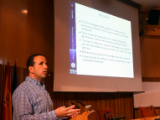IMDEA Networks

IMDEA Networks participates in the T3chFest at UC3M
29 February 2016

IMDEA Networks took part in the 4th edition of the UC3M T3chFest celebrated last week at the Leganés campus. More than 700 participants benefited from a multifaceted and highly interesting program focused on new technologies.
On Thursday, February 11th 2016, UC3M opened the doors for the 4th edition of T3chFest, a yearly event that brings together students, researchers and start-ups as well as established companies and specialists in new technologies.
More than 700 people participated in the two-day event which encompassed more than 60 talks, five workshops and two programming competitions. A new feature at this year’s event was the celebration of a Google Hashcode Challenge, consisting of an engineering problem to be resolved through programming.
IMDEA Networks’ PhD Student, Roberto Calvo contributed to the event program as one of the main speakers during the first day. He started out by giving an overall presentation of IMDEA Networks Institute and its lines of research aimed especially at the congregated students who might be interested in the various job opportunities available to them in a diversified and multicultural research community as is IMDEA Networks. Secondly, he went on to the main point of his presentation: the Wideband Spectrum Monitoring System project which forms the foundation of his PhD thesis.
In his presentation, he shed light on some important aspects of the research project: Today's spectrum measurements are mainly performed by governmental agencies using expensive, specialized hardware. Each country creates and maintains its own national frequency allocation plan which specifies how the electromagnetic (EM) spectrum should be used. Although the EM spectrum is well-organized in terms of frequency allocation, its actual usage in different geographical places and time zones is still a rather unknown matter. The idea of distributed spectrum monitoring has recently started to gain attention from various research communities who are interested in capturing the real-time usage of the EM spectrum at a large geographical scale. In future, knowing the EM spectrum in real time, radio transmitters could work more efficiently as they would be able to make use of frequencies available in each location.
One of the primary goals with the project is to build a detailed map of the current EM spectrum usage created by crowd-sourcing, with a view to democratizing the access and knowledge of the radio spectrum. Cognitive radios would then be able to use the data as a baseline in order to optimize their efforts to dynamically access the spectrum. This could very well lead to the emergence of new desirable services for a wide range of different applications, thus ensuring better wireless internet services for society at large. The idea is that the radio transmitters in the future will be able to dynamically detect which is the more efficient spectrum to transmit in each moment, increasing the communications speed. The spectrum map might also be used to identify regions with high/low levels of electro smog, which again might be an incentive for users to participate in the crowd-sourcing system.
The assembled group of students, company delegates and specialists were invited to ask questions at the end of Roberto’s presentation which concluded the first day of an event focused on such an interesting theme as that of IT and new technologies.


Recent Comments